Here - the ESAFORM 2008 Conference - INSA de Lyon
Here - the ESAFORM 2008 Conference - INSA de Lyon
Here - the ESAFORM 2008 Conference - INSA de Lyon
Create successful ePaper yourself
Turn your PDF publications into a flip-book with our unique Google optimized e-Paper software.
Process parameters influence on friction coefficient in sheet formingoperationsE. Ceretti 1 , A. Fiorentino 1 , C. Giardini 21 University of Brescia, Dept. of Mechanical and Industrial Engineering - Via Branze 38, 25123 Brescia, ItalyURL: www.ing.unibs.it/tecmece-mail: elisabetta.ceretti@unibs.it; antonio.fiorentino@unibs.it2 University of Bergamo, Dept. of Design & Technologies - Viale Marconi 5, 20044 Dalmine (BG), Italye-mail: claudio.giardini@unibg.itABSTRACT: In conventional sheet forming processes, such as stamping or drawing, significant contactphenomena take place between workpiece and die surfaces. Especially, relative motion and normal loadsgenerate friction which influences some aspects of processes such as material flow, tools wear and life andtotal force nee<strong>de</strong>d to complete <strong>the</strong> process. In <strong>the</strong> current paper an experimental test campaign has beencarried out using a large scale pin-on-disk <strong>de</strong>vice <strong>de</strong>signed and realized by <strong>the</strong> Authors to investigate <strong>the</strong>influence of pressure, sliding velocity and temperature. The purpose is to test <strong>the</strong> <strong>de</strong>veloped <strong>de</strong>vice and to findwhich and how <strong>the</strong>se parameters mostly affect friction. The pin-on-disk test consists of two specimens, a pinand a plate representing respectively die and workpiece, which are compressed by means of a known forceand <strong>the</strong>n moved one over <strong>the</strong> o<strong>the</strong>r. Compression and friction forces are sampled during <strong>the</strong> tests and <strong>the</strong>friction coefficient is estimated as <strong>the</strong> ratio of <strong>the</strong>se two forces. The tested materials are H13 die steel onFeP04 and AZ31 sheets.Keywords: sheet forming, friction, contact problems, temperature, pressure, velocity.1 INTRODUCTIONIn conventional manufacturing operation significantcontact phenomena take place between tool andworkpiece. Due to this contact and <strong>the</strong> resultingsurface interactions, friction is generated. Frictionknowledge is very important because it affects manyaspects of manufacturing processes, such as <strong>the</strong>required force, <strong>the</strong> die wear and in some cases <strong>the</strong>process feasibility.To investigate and to <strong>de</strong>termine <strong>the</strong> friction valueseveral tests, such as ring test [1] and strip test [2],and <strong>the</strong> Pin-on-Disk [3] have been introduced. Inrecent years many Authors have proposed newmethods to evaluate friction, for example <strong>the</strong>modified LDH [4], <strong>the</strong> Twist Compression Test [5].Among <strong>the</strong>se tests Pin-on-Disk (PoD) allows todirectly measure <strong>the</strong> compression (F) and friction(T) forces and to estimate <strong>the</strong> friction coefficient(µ=T/F) using one single couple of surfaces incontact.In previous works <strong>the</strong> Authors studied <strong>the</strong> influenceof contact pressure, sliding velocity and materialroughness on friction coefficient by using a self<strong>de</strong>signedPin-on-Disk equipment [6, 7, 8]. In <strong>the</strong>seworks, <strong>the</strong> H13 steel and different die coatings weretested on AISI 5115 and on Series 1 Aluminiumpainted sheets. The i<strong>de</strong>a was to i<strong>de</strong>ntify <strong>the</strong><strong>de</strong>pen<strong>de</strong>nce of friction on <strong>the</strong> process parametersand to implement it in FE co<strong>de</strong>s.The aim of <strong>the</strong> present work is to study <strong>the</strong> influenceof contact pressure, sliding velocity and temperatureon friction while forming different materials, namely<strong>de</strong>ep drawing steel FeP04 and AZ31 Magnesiumalloy sheets. Since this latter is characterized by ahigh formability in warm forming [9], <strong>the</strong>temperature influence was studied too.2 EXPERIMENTAL EQUIPMENTThe experimental <strong>de</strong>vice (Fig. 1 left) is a large scalePin-on-Disk tribometer <strong>de</strong>signed by <strong>the</strong> Authors [7].The friction coefficient is evaluated by pushing intocontact two components called Pin and Plate. ThePin (a cylin<strong>de</strong>r with a diameter of 12 mm and acorner radius of 2 mm) stands for <strong>the</strong> die (or more ingeneral <strong>the</strong> tool) and is mounted on a carriage whichcan move orthogonally with respect to <strong>the</strong> platesurface. The Plate (flat) represents <strong>the</strong> workpieceand it is mounted on a disk that rotates so
















